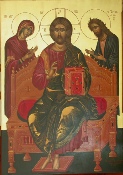



Christianity's first five centuries were marked by relative unity. Christ's apostles and their successors spread His teachings and converted millions. Rapid growth of the new faith, despite persecution of the faithful by various pagan authorities, attested to the strength and depth of their Christian convictions.
The church grew and so did its hierarchy. Bishops were named in the East, in Jerusalem, Antioch, Alexandria, and Constantinople, and in the West, in Rome. As the Roman Empire divided in the fifth century, so the once united Christian Church started drifting apart, politically and dogmatically. Theological issues, including the Roman Bishop's intention to be the universal head of all Christianity, led to a complete split in 1054.
In that year, the Christian church split into the eastern and western branches. The western "Roman Catholic" branch of the Christian church was headed by the principal Bishop in Rome, later titled Pope. The "Eastern Orthodox" branch was an entity comprised of autonomous national churches, each headed by its preeminent Bishop, later called Patriarch. Although the primates of the eastern branch, the Patriarchs heading the Orthodox churches in eastern and southern Europe and the Middle East, retained full autonomy over the faithful in their regions, they considered the Patriarch of Constantinople primus inter pares , the first among equals. In contrast, the Pope in Rome assumed autonomous spiritual reign over all Roman Catholic faithful in the world.
In the 14th century, both sides lost ground to Mohammedan Islam, which surged across the Middle East and Northern Africa. Constantinople, seat of the leading Patriarch and the crown city of the Byzantine Empire, fell to the Ottomans in 1453, as did the Balkans, northern Africa, and part of Spain. Practically all ethnic Greeks, the Orthodox Christian backbone of Byzantium, became subjects of the Sultan; the Patriarchs and other clerics were compelled to administer their millets of Christians and answer to Ottoman authority.
A further split occurred in the Roman Catholic church 1517-
By the 19th century, the Ottoman power was in retreat and the Orthodox churches in the Balkans, aided by the powerful Orthodox Church of Russia, headed by the Patriarch in Moscow, again established their national autonomies. Following a successful uprising against the Ottomans in 1821, the Greek Orthodox Church in newly independent Greece also claimed autonomy within the Greek borders, separate and apart from the Patriarchate in Constantinople.
As European immigrants arrived in America, they brought their multiplicity of religions with them. In fact among the 17th and 18th century settlers many chose to emigrate to the new world precisely because they could practice their own brand of Christianity. Orthodoxy found a significant foothold in Alaska, when Russian traders and settlers established Russian Orthodox parishes, built churches, and converted numerous indigenous people. In fact, until 1908, the Russian Patriarchate [in Czarist Moscow] claimed jurisdiction over all Orthodox churches in North America, by simply extending its 18 th century claim over Alaska and other parishes that dotted the West Coast all the way south to San Francisco.
However, in the late 1800s and early 1900s, as eastern Orthodox Christians began to immigrate into the United States in greater numbers, most new Americans chose to retain their religious and spiritual ties to their old country churches. Thus one could follow the establishment of various Eastern Orthodox churches and parishes, bearing the prefix "Antiochian," "Syrian," "Russian," "Serbian," "Bulgarian," "Romanian," and "Greek."
Although the Ecumenical Patriarchate in Constantinople [renamed Istanbul by the new
Turkish state] traditionally had jurisdiction over Greek Orthodox churches outside
the borders of Greece, many early Greek Orthodox parishes in the US had ties to the
church in the mother country -
A potential conflict was avoided when in 1922 the majority of Greek Orthodox churches
followed Archbishop Meletios and Bishop Alexander of Rodostolon and, after the first
Clergy -
You can read more about the history of Greek Orthodox parishes established by Greek
immigrants to the southern states in Chapter 4 "From Byzantine Rites to Civil Rights:
The Greek Orthodox Church in the United States", in the book "Demetrios Is Now Jimmy:"
Greek Immigrants in the Southern United States, 1895-
